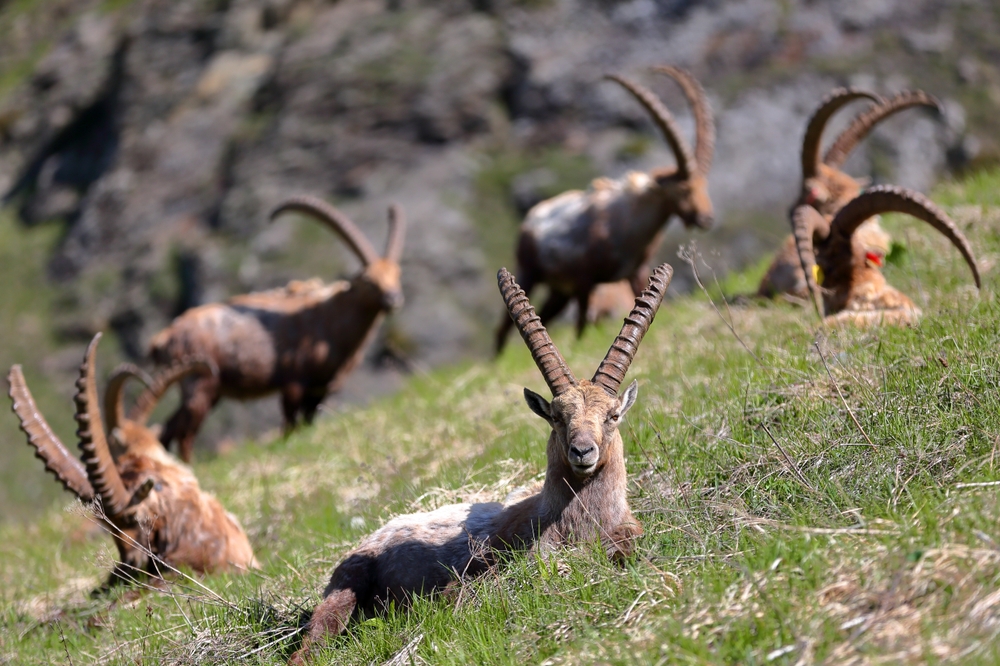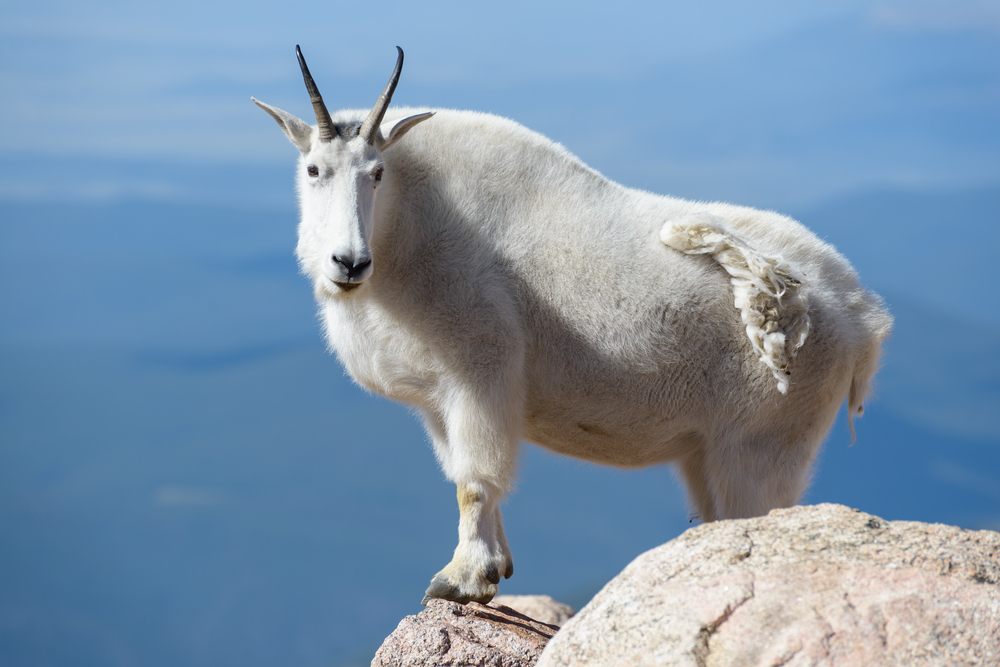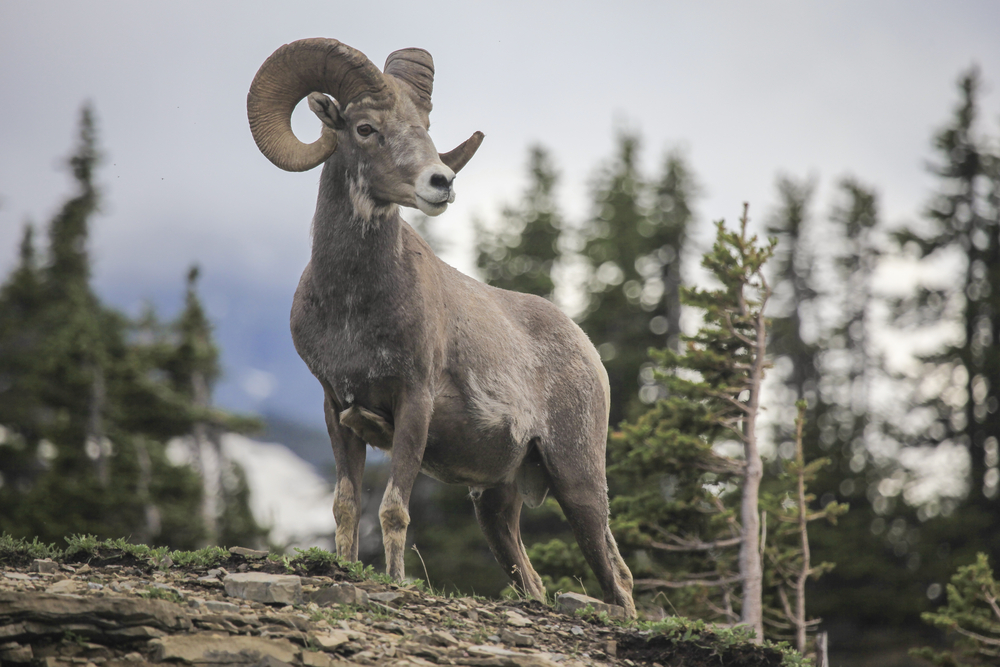The Alpine ibex (Capra ibex) is most closely related to other wild goats in the genus Capra, particularly the Siberian ibex (Capra sibirica) and the Spanish ibex (Capra pyrenaica). It also shares ancestry with the domestic goat (Capra hircus).
About
The Alpine ibex (Capra ibex) is a wild mountain goat species celebrated for its impressive climbing skills and massive, backward-curving horns. It belongs to the family Bovidae, which also includes antelope, bison, buffalo, and domestic goats. Native to the European Alps, the Alpine ibex thrives in steep, rocky terrain at elevations between 1,800 and 3,300 meters (5,900–10,800 feet), where its agility and sure-footedness provide safety from most predators.
Males, or billies, are larger than females (nannies), weighing 67–117 kg (150–258 lbs) compared to 17–32 kg (37–71 lbs) for females. Males sport spectacular horns that can grow up to 1 meter (39 inches) long and feature prominent ridges, while females have shorter, thinner horns. Their coats change seasonally—thick and brownish-gray in winter for insulation, and shorter, lighter-colored fur in summer for heat management.
Alpine ibex are herbivores, grazing on alpine grasses, herbs, mosses, and lichens in summer and browsing shrubs, twigs, and evergreen vegetation in winter. They are exceptionally adapted to their rugged habitat, with specialized split hooves and rough hoof pads that grip rocky surfaces, enabling them to navigate cliffs where few predators can follow.
Once widespread in the Alps, the species faced near-extinction in the early 19th century due to overhunting. Conservation efforts, particularly in Italy’s Gran Paradiso National Park, saved the ibex, and today they are reintroduced and thriving in many alpine regions. Populations are stable, and they have become a symbol of successful wildlife recovery in Europe.
During mating season (late autumn to early winter), males compete for dominance through horn clashes, with winners gaining access to harems of females. Kids are typically born in spring, when fresh vegetation is available.
The Alpine ibex remains an iconic emblem of Europe’s mountain wilderness, admired for its resilience, strength, and mastery of high-altitude living.
Physical Characteristics
The Alpine ibex (Capra ibex) is a wild mountain goat native to the European Alps, recognized for its impressive horns and rugged build:
-
Coat: Dense, short summer coat that is light brown to tan; in winter, the coat becomes longer, thicker, and darker for insulation against cold alpine temperatures.
-
Head: Narrow face with a straight profile and small, pointed ears.
-
Horns: Both males and females have horns, but males’ are massive, arching backward and reaching up to 40 in (100 cm) in length, with distinct ridges along the outer curve. Females’ horns are shorter, slender, and less curved.
-
Body: Stocky, muscular frame with a broad chest, short neck, and powerful shoulders and hindquarters for climbing steep terrain.
-
Legs: Short, strong legs with cloven hooves that have sharp edges and rubbery pads, providing exceptional grip on rocky surfaces.
-
Tail: Short and tufted, usually dark in color.
Size:
-
Length (Body): Approximately 4.3 to 5.3 ft (1.3 to 1.6 m) from head to rump.
-
Shoulder Height: Around 2.6 to 3.3 ft (0.8 to 1.0 m).
Weight:
-
Adult Female: Typically 65 to 110 lbs (30 to 50 kg).
-
Adult Male: Usually 150 to 270 lbs (70 to 123 kg).
The Alpine ibex’s muscular build, specialized hooves, and massive horns make it perfectly adapted for survival in the steep, rocky cliffs and alpine meadows of the high mountains.
Reproduction
The Alpine ibex has a seasonal breeding cycle adapted to the harsh alpine environment, ensuring young are born when conditions are most favorable:
-
Mating and Breeding Season:
-
Breeding occurs during the rut in late fall to early winter (December to January).
-
Males compete for females through displays of dominance, horn-clashing battles, and posturing.
-
-
Gestation:
-
The gestation period lasts about 167 to 170 days (roughly 5.5 months).
-
-
Birth and Calving:
-
Females give birth in late spring to early summer (May to June) when alpine meadows provide fresh vegetation for nursing mothers.
-
Usually a single kid is born; twins are rare.
-
-
Kid Characteristics at Birth:
-
Newborns weigh about 6 to 11 lbs (3 to 5 kg).
-
They are precocial—able to stand and follow their mother within hours, a necessity in predator-prone and rugged terrain.
-
-
Maternal Care:
-
Mothers nurse and protect their young, often choosing secluded cliff ledges to avoid predators.
-
Weaning occurs around 4 to 6 months, though young may remain with their mothers until the next breeding season.
-
-
Maturity and Breeding Readiness:
-
Females typically reach sexual maturity at 2 to 3 years.
-
Males mature physically by 5 years but often do not successfully breed until they are 8 to 10 years old, when they are strong enough to compete with older rivals.
-
The Alpine ibex’s late breeding maturity in males, synchronized birth timing, and maternal vigilance are key adaptations for survival in the challenging conditions of the high Alps.
Lifespan
In the Wild:
Alpine ibex typically live 10 to 14 years, with females often living slightly longer than males. Harsh winters, predation, and the physical demands of rutting reduce average lifespans, especially for older males.
In Captivity:
In wildlife reserves, zoos, or managed alpine enclosures with veterinary care and reliable food, Alpine ibex can live up to 18–20 years.
Threats to Longevity:
-
Environmental Stress: Severe winters with deep snow can limit access to forage, leading to starvation.
-
Predation: Golden eagles, wolves, and lynx may prey on kids; adults have few natural predators.
-
Injury & Rut Stress: Males may suffer injuries or exhaustion during the intense rutting season.
-
Disease & Parasites: Internal and external parasites can weaken individuals, especially in dense populations.
-
Avalanches & Rockfalls: Living in steep terrain exposes ibex to natural hazards.
The Alpine ibex’s adaptations for mountain life allow it to thrive in one of Europe’s harshest environments, but the rugged habitat also places natural limits on its lifespan.
Eating Habits
The Alpine ibex is an herbivorous grazer and browser, adapted to extract nutrition from sparse alpine vegetation:
-
Primary Diet:
-
Summer: Grazes on alpine meadow grasses, sedges, clovers, herbs, and wildflowers.
-
Spring: Consumes fresh shoots, buds, and leaves as snow melts and plants begin to grow.
-
Autumn: Feeds on shrubs, twigs, mosses, and lichens as herbaceous plants die back.
-
Winter: Survives on woody plants, bark, evergreen needles, and any dried grasses it can uncover through snow.
-
-
Foraging Behavior:
-
Spends the warm months at higher elevations (above 8,000 ft / 2,400 m) and descends to lower slopes in winter to find accessible food.
-
Highly selective feeder in summer, but less choosy in winter when food is scarce.
-
-
Digestive Adaptations:
-
As a ruminant, has a four-chambered stomach that ferments fibrous plant material, allowing it to efficiently digest low-nutrient alpine forage.
-
-
Water Needs:
-
Gets most of its water from moisture-rich plants and snow; drinks from mountain streams when available.
-
The Alpine ibex’s seasonal feeding shifts and ability to digest tough vegetation are critical to surviving in the nutrient-poor, high-altitude environment of the European Alps.
Uniqueness
The Alpine ibex (Capra ibex) is a mountain specialist with a set of traits that make it one of the most remarkable wild goats in the world:
-
Impressive Horns: Males grow massive, backward-curving horns up to 40 in (100 cm) long with prominent ridges; females have shorter, slender horns.
-
Extreme Climbing Ability: Possesses exceptional balance and agility, able to scale near-vertical cliffs and traverse ledges only a few inches wide to escape predators and reach forage.
-
Cold-Weather Adaptation: Seasonal coat changes—from a short, light-brown summer coat to a thick, dark winter coat—allow survival in sub-zero alpine conditions.
-
High-Altitude Lifestyle: Lives year-round at elevations between 5,000 and 11,500 ft (1,500–3,500 m), rarely descending to valley floors except in severe winters.
-
Specialized Hooves: Cloven hooves with concave undersides and rubbery pads provide an exceptional grip on rock, ice, and steep slopes.
-
Conservation Success Story: Once nearly extinct in the early 19th century, the Alpine ibex was restored through strict protection and reintroduction programs in the Alps.
-
Social Structure: Females and young form herds, while mature males often remain solitary outside the breeding season.
The Alpine ibex’s combination of climbing skill, high-altitude adaptation, and conservation history makes it an emblematic species of Europe’s mountain wilderness.
Be the First to Share Photos of This Species.
FAQ’s
1. What is the closest species to the Alpine ibex?
2. How does the Alpine ibex compare to other goat species?
The Alpine ibex is more specialized for steep, rocky alpine habitats than most goat species. Compared to domestic goats, it is stockier, has much longer horns (especially in males), and a thicker seasonal coat. Unlike lowland or desert-adapted goats, it lives year-round at high elevations and can scale near-vertical cliffs with ease.
3. What national parks provide the best chances to see an Alpine ibex?
Alpine ibex are found in several protected areas across the European Alps, including:
-
Gran Paradiso National Park (Italy) – the first park to protect and restore the species.
-
Vanoise National Park (France) – strong population in alpine meadows and rocky slopes.
-
Swiss National Park (Switzerland) – reintroduced herds thriving in high mountain terrain.





































































